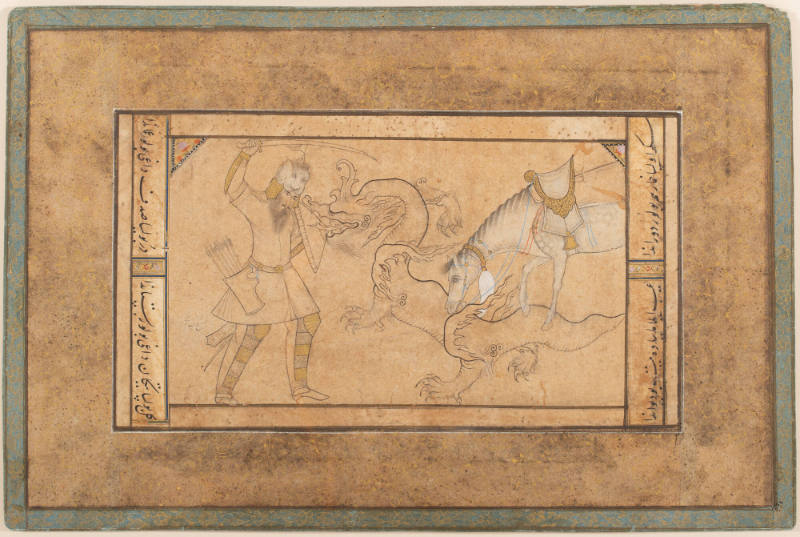
In the Moak Gallery, Floor 2L
Drawn from the Johnson Museum’s permanent collection, this exhibition highlights the epics of powerful Persian kings and heroes and their romantic love stories through poetry, paintings, and calligraphy. During the Timurid (1370–1507) and Safavid (1501–1722) periods, Persia encompassed an area that includes today’s Iran, Afghanistan, and parts of Central Asia that produced a rich history of culture and art. Persian kings, interested in ensuring that their bravery and victories, power, and wealth were documented, commanded their royal poets to pen their heroisms in exaggerated styles. Well-known and highly skilled painters and calligraphers would then illustrate and contextualize the brave actions of these hero kings in books that showcased the ideals of the royal court.
The paintings in this exhibition illustrate the poetry of well-known Persian poets like Firdausi, Nizami, Jami, Attar, and Hafiz. Many of the pictures come from the famous Shahnama (Book of Kings) or Khamsa (Quintet). For a contemporary audience, these illustrations, in addition to their artistic importance, are a means for visually entering the world of the royal courts and imagining the spirit of patron rulers who each brought their own views about how the illustrations and calligraphy should be expressed artistically.
It was during the Timurid period that the capital of Persia was established in Samarqand (in modern Uzbekistan) and later in Herat (in modern Afghanistan). The Timurid period encompassed one of the most brilliant periods of science, knowledge, and art in the Persian world when calligraphy, book illustration, illumination, and bookbinding reached the peak of perfection, especially in Herat.
The Safavid dynasty came into power with Shah Ismail Safavid, who unified Iran, captured Herat and established his capital in Tabriz. That city, along with later Safavid capitals at Qazvin and Isfahan, are associated with the evolution of Safavid painting, while Herat, Mashhad, and Bukhara continued to produce manuscripts of Persian literature. Innovations in compositional devices and the interplay of architecture and landscape first were developed during Shah Ismail’s reign, but some of the Safavid court workshop’s best works were created under the patronage of Shah Tahmasp, who brought masters from Herat to Qazvin. Zahir ad-Din Muhammad Babur (1483–1530), who was the fifth descendant of Timur, marched into India in 1526 and founded the Mughal Empire there, spreading Persian literature and art to India and South Asia.
Persian poets have written in different formats to express historical epics or stories of love. In the epic poem Shahnama, Firdausi’s emphasis on heroism and tracing royal legitimacy to ancient foreign kings like Alexander the Great made it desirable to the rulers of Iran. In the love stories of the Khamsa, which involve some of the same historical characters as in Shahnama, Nizami’s writing is infused with aspects of Sufism, a religious-philosophical movement in Islam, with mysticism at its core.
Other calligraphic works in the exhibition include the ghazal, one of the most famous forms of Persian poetry, expressing spiritual and romantic love, especially the pain of loss or separation from the beloved and the beauty of love in spite of that pain.
The Poetic World of Persian Art was curated by Sharifa “Elja” Sharifi, visiting scholar and 2022–23 Artist Protection Fund Fellow at the Johnson Museum, under the supervision of Ellen Avril, chief curator and the Judith H. Stoikov Curator of Asian Art. The exhibition is supported in part by the Robert J. Appel Exhibition Fund.
Selected Artworks

Diwan of Amir Shahi
Persian, Herat

Youth with an incense burner
Iran, Safavid period

Battle between the conquering Mongols and the Muslim population of Iran, page from the Tarikh-i Jahan Gushay of Juvayni
Atelier of Ibrahim Sultan ibn Shah Rukh

Rustam fights Afrasiyab, page from a Shahnama
Iran, Safavid period
Emperor Jahangir’s seal impression and shamsa
India, Mughal
Emperor Jahangir’s seal impression and shamsa
India, Mughal
India, Mughal. Emperor Jahangir’s seal impression and shamsa, 1611–12 (regnal year 6). Ink, colors, and gold on paper. Calligraphy: 2 1/8 inches diameter; backing: 11 7/16 x 6 7/8 inches. Newly acquired through the George and Mary Rockwell Fund.
















